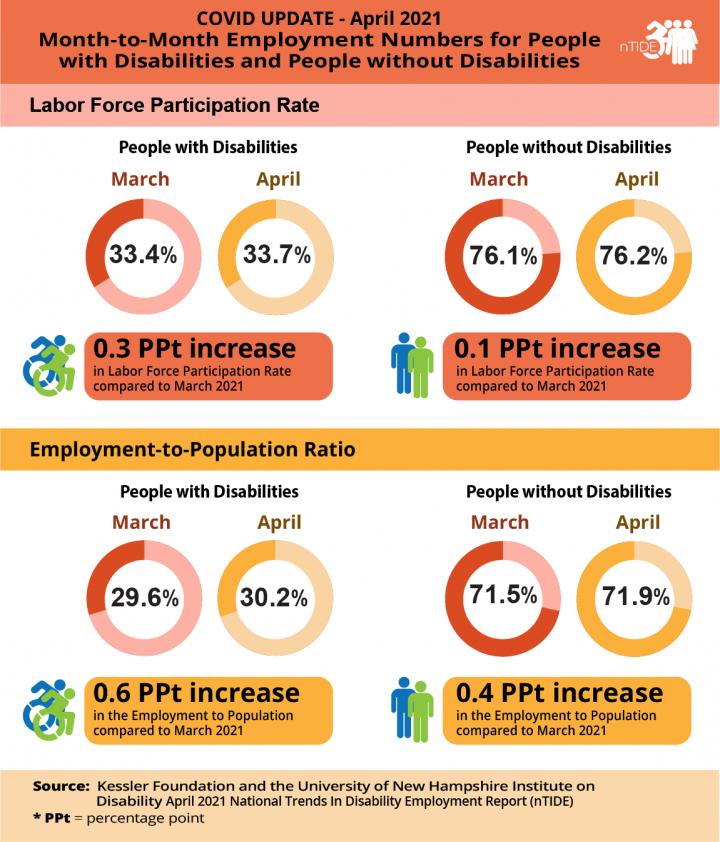National Trends in Disability Employment (nTIDE) – issued monthly by Kessler Foundation and the University of New Hampshire

Credit: Kessler Foundation
East Hanover, NJ – May 7, 2021 – Incremental gains in the economic indicators for people with and without disabilities are positive signs of economic recovery, according to today’s National Trends in Disability Employment – Monthly Update (nTIDE), issued by Kessler Foundation and the University of New Hampshire’s Institute on Disability (UNH-IOD). The decline in COVID-19 cases, the increase in immunity in the U.S. population, and reopening in certain sectors, appear to be contributing to job gains.
nTIDE COVID Update (month-to-month comparison)
In the Bureau of Labor Statistics (BLS) Jobs Report released Friday, the employment-to-population ratio for working-age people with disabilities increased from 29.6 percent in March to 30.2 percent in April 2021 (up 2 percent or 0.6 percentage points). For working-age people without disabilities, the employment-to-population ratio also increased from 71.5 percent in March to 71.9 percent in April 2021 (up 0.6 percent or 0.4 percentage points). The employment-to-population ratio, a key indicator, reflects the percentage of people who are working relative to the total population (the number of people working divided by the number of people in the total population multiplied by 100).
“The minor gains in the employment-to-population ratios in February and March now appear to be the beginning of a trend back to pre-COVID employment levels for both people with and without disabilities,” said John O’Neill, PhD, director of the Center for Employment and Disability Research at Kessler Foundation. “The additional increases in April may be a harbinger of better employment outcomes going forward,” he added.
The labor force participation rate for working-age people with disabilities increased from 33.4 percent in March to 33.7 percent in April 2021 (up 0.9 percent or 0.3 percentage points). For working-age people without disabilities, the labor force participation rate also increased from 76.1 percent in March to 76.2 percent in April 2021 (up 0.1 percent or 0.1 percentage points). The labor force participation rate is the percentage of the population that is working, not working and on temporary layoff, or not working and actively looking for work.
“The rise in labor force participation for people with and without disabilities may be due to more Americans being immunized and feeling it is safer to return to the workplace,” said economist Andrew Houtenville, PhD, research director of the University of New Hampshire’s Institute on Disability. “While small, these modest gains are positive overall.”
Traditional nTIDE Numbers (comparison to the same time last year)
The employment-to-population ratio for working-age people with disabilities increased from 26.3 percent in April 2020 to 30.2 percent in April 2021 (up 14.8 percent or 3.9 percentage points). For working-age people without disabilities, the employment-to-population ratio also increased from 63.2 percent in April 2020 to 71.9 percent in April 2021 (up 13.8 percent or 8.7 percentage points).
The labor force participation rate for working-age people with disabilities increased from 32.7 percent in April 2020 to 33.7 percent in April 2021 (up 3.1 percent or 1 percentage points). For working-age people without disabilities, the labor force participation rate also increased from 73.6 percent in April 2020 to 76.2 percent in April 2021 (up 3.5 percent or 2.6 percentage points).
In April 2021, among workers ages 16-64, the 4,616,000 workers with disabilities represented 3.3 percent of the total 141,151,000 workers in the U.S.
nTIDE COVID Update – Friday, May 21 at 12:00 pm Eastern
Stay tuned for our mid-month update about the employment of people with disabilities as we follow the impact of COVID-19 and look at the numbers in more detail.
Ask Questions about Disability and Employment
Each nTIDE release is followed by a nTIDE Lunch & Learn webinar. This live broadcast, hosted via Zoom Webinar, offers attendees Q&A on the latest nTIDE findings, provides news and updates from the field, as well as invited panelists to discuss current disability-related findings and events. On May 7, at 12:00 pm Eastern, Andrew Imperato, executive director of Disability Rights California, joins Drs. Houtenville and O’Neill, Elaine E. Katz of Kessler Foundation, and Denise Rozell, Policy Strategist at AUCD. Join live or watch the recordings at: ResearchonDisability.org/nTIDE.
NOTE: The statistics in the nTIDE are based on Bureau of Labor Statistics numbers but are not identical. They are customized by UNH to combine the statistics for men and women of working age (16 to 64). nTIDE is funded, in part, by grants from the National Institute on Disability, Independent Living and Rehabilitation Research (NIDILRR) (90RT5037) and Kessler Foundation.
###
About Kessler Foundation
Kessler Foundation, a major nonprofit organization in the field of disability, is a global leader in rehabilitation research that seeks to improve cognition, mobility, and long-term outcomes — including employment — for people with neurological disabilities caused by diseases and injuries of the brain and spinal cord. Kessler Foundation leads the nation in funding innovative programs that expand opportunities for employment for people with disabilities. For more information, visit KesslerFoundation.org.
About the Institute on Disability at the University of New Hampshire
The Institute on Disability (IOD) at the University of New Hampshire (UNH) was established in 1987 to provide a coherent university-based focus for the improvement of knowledge, policies, and practices related to the lives of persons with disabilities and their families. For information on the NIDILRR-funded Employment Policy and Measurement Rehabilitation Research and Training Center, visit ResearchonDisability.org.
For more information, or to interview an expert, contact:
Carolann Murphy, 973.324.8382, [email protected].
Media Contact
Carolann Murphy
[email protected]




